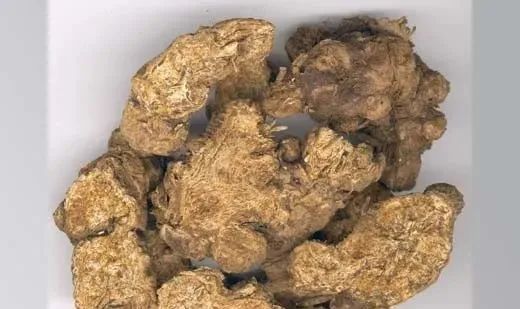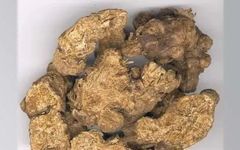Providing you with knowledge on health and wellness
Don’t forget to follow us to prevent losing us next time
to prevent losing us next time
This herb is a commonly used traditional Chinese medicine (TCM). It is classified as a superior herb in the “Shen Nong’s Materia Medica”. Originally named “Zhu” (术), it was later differentiated into Bai Zhu (白术, White Atractylodes) and Cang Zhu (苍术, Atractylodes lancea) by Tao Hongjing in the “Record of Famous Physicians”. Currently, Cang Zhu is divided into two categories: one produced in East China and South Central China, which, when sliced, reveals white mold resembling hair, known as Mao Cang Zhu (毛苍术, Hairy Atractylodes). The other, produced in Northeast China and East China, does not develop white mold when sliced and is referred to as Shan Cang Zhu (山苍术, Mountain Atractylodes).
Aliases: Mao Cang Zhu (毛苍术, Hairy Atractylodes), Bei Cang Zhu (北苍术, Mountain Atractylodes).
Source: The dried rhizomes of the perennial herbaceous plants in the Asteraceae family: Mao Cang Zhu (Atractylodes lancea (Thunb.) DC.) and Bei Cang Zhu (Atractylodes chinensis (DC.) Koidz.). Both are wild-harvested.

Production Areas: Mao Cang Zhu is primarily produced in the Maoshan area of Jiangsu Province (hence the name Mao Cang Zhu), as well as in Xiangfan, Hubei Province, Xinyang, and Nanyang areas of Henan Province. It is also produced in Anhui, Zhejiang, Jiangxi, and other provinces. Shan Cang Zhu is mainly produced in North China and Northeast provinces, with production also in Shandong, Shaanxi, and Gansu.
Identification: Mao Cang Zhu appears irregularly bead-like, resembling connected lumps, with a curved and constricted shape, varying in size. It measures 2-10 cm in length and 0.8-1.5 cm in diameter. The skin is dark brown and slightly rough, with root scars and short fibrous roots, and may have stem scars or remnants. It is solid and easily broken. The cross-section is yellowish-white or grayish-white, with distinct reddish-brown oil glands scattered throughout, commonly referred to as “vermilion dots”. When the cut surface is moistened, fine needle-like crystals resembling white mold can be observed. It has a fragrant aroma, with a slightly sweet and then bitter-spicy taste. The best quality is characterized by a bead-like shape, solid texture, dark brown skin, and yellowish-white cross-section with visible vermilion dots.
Shan Cang Zhu: The shape and color are slightly similar to Mao Cang Zhu, but it is generally larger and more robust. It measures about 3-15 cm in length and 1-3 cm in diameter, with a solid texture, though slightly looser than Mao Cang Zhu. The cross-section is yellowish-white, with a slightly radiating pattern resembling a chrysanthemum heart, and has fewer reddish-brown oil glands. When the cut surface is moistened, no needle-like crystals are observed, and its aroma is less intense than that of Mao Cang Zhu, with a sweet and slightly bitter taste. The best quality is characterized by a plump, solid form, clean of fibrous roots, and fragrant aroma.
Main Components: Contains volatile oils, primarily Atractylon (C15H26O) and Atractylone (C15H20O). Also contains significant amounts of vitamin A and vitamin D (note: the water decoction does not contain vitamin A).
Efficacy and Functions: 1. Strengthens the stomach. 2. Promotes diuresis and sweating; the diuretic effect is not significant but can increase the excretion of sodium and potassium in urine. 3. Calming effect, with effective components being volatile oils. 4. Lowers blood sugar. 5. Strengthening effects, possibly related to its vitamin content.
Preparation: Peel, stir-fry with rice wash, and dry-fry.
Nature and Flavor: Spicy, bitter, and warm.
Meridians: Enters the Spleen and Stomach meridians.
Functions: Dries dampness and strengthens the Spleen, dispels wind-dampness.
Indications: Used for digestive disorders caused by dampness obstructing the Spleen, leading to loss of appetite, nausea, abdominal distension, and diarrhea; joint and limb pain.
Clinical Applications: An important herb for dispelling dampness, applicable for both internal and external dampness. Historical experience states: “Cang Zhu is most effective for treating external dampness.”
1. Used for treating indigestion (commonly referred to as dampness obstructing the middle burner), characterized by fullness and discomfort in the stomach, loss of appetite, or vomiting and diarrhea, often combined with Hou Po (厚朴, Magnolia Bark) and Chen Pi (陈皮, Aged Tangerine Peel) in formulas like Ping Wei San (平胃散, Stomach-Soothing Powder); if there is a tendency towards heat stagnation, it can also be combined with Xiang Fu (香附, Cyperus) and Shen Qu (神曲, Fermented Barley) or Zhi Zi (栀子, Gardenia).
2. Used for treating diarrhea, especially summer diarrhea with significant damp-heat, often combined with Yin Hua (银花, Honeysuckle) and Fu Ling (茯苓, Poria).
3. Used for treating wind-dampness, particularly muscular wind-dampness. Commonly combined with Ma Huang (麻黄, Ephedra), Gui Zhi (桂枝, Cinnamon Twig), and Yi Yi Ren (苡仁, Job’s Tears) to enhance analgesic effects. If there is heat bi syndrome with fever, thirst, and severe joint pain with redness and swelling, along with a yellow tongue coating and rapid pulse, it can be combined with Shi Gao (石膏, Gypsum) and other heat-clearing herbs in formulas like Bai Hu Jia Cang Zhu Tang (白虎加苍术汤, White Tiger Decoction with Atractylodes).
4. Used in surgery, showing certain effectiveness in treating jaundice and perianal tuberculosis. It can also treat abdominal distension and pain in the lower limbs caused by damp-heat, resembling erysipelas, often combined with Huang Bai (黄柏, Phellodendron) and Niu Xi (牛膝, Achyranthes) in formulas like Si Miao Wan (四妙丸, Four Marvels Pill).
5. Used in ophthalmology for treating night blindness and corneal softening after measles, utilizing its vitamin A content, often taken in pill or powder form (there are reports of effectiveness with decoction). It can be used alone as a powder or combined with Mu Zei (木贼, Equisetum). Prescription: Cang Zhu 120g, Mu Zei 60g, ground into powder and mixed; taken with vegetables 3-6g at meal times, or combined with male sheep liver.
Additionally, it can be used for strengthening. It treats fatigue, weakness in limbs, particularly in cases of deficiency and cold, often combined with Shu Di (熟地, Rehmannia) and Gan Jiang (干姜, Dried Ginger).
Usage Precautions: Cang Zhu is relatively spicy and drying, thus not suitable for those with yin deficiency, blood dryness, or those experiencing hemoptysis or epistaxis.
Note: Both Cang Zhu and Hou Po can transform dampness. When treating fullness and vomiting in the gastrointestinal tract, they are often used together, but Cang Zhu is more effective in dispelling wind and drying dampness; for warming the middle and relieving fullness, Cang Zhu is less effective than Hou Po.
Dosage: 3-9g.
Example Formulas: 1. Ping Wei San (平胃散, Stomach-Soothing Powder) (from “Jufang”): Cang Zhu 9g, Hou Po 6g, Chen Pi 6g, Gan Cao (甘草, Licorice) 3g, decoct in water for oral administration.
2. Bai Hu Jia Cang Mu Tang (白虎加苍木汤, White Tiger Decoction with Atractylodes) (modified): Cang Zhu 9g, Sheng Shi Gao (生石膏, Raw Gypsum) 30g (crushed and decocted first), Zhi Mu (知母, Anemarrhena) 12g, Gan Cao 6g, Sang Zhi (桑枝, Mulberry Twig) 12g, Fang Ji (防己, Stephania) 9g, Yin Hua Teng (银花藤, Honeysuckle Vine) 9g, decoct in water for oral administration.
3. Si Miao Wan (四妙丸, Four Marvels Pill) (from “Dan Xi Xin Fa”): Cang Zhu, Huang Bai, Niu Xi, and Sheng Yi Ren in equal parts, ground into powder, made into pills, taken 6-9g with warm water.
Disclaimer: This article is reproduced from the internet and published materials. If there is any infringement, please contact us for removal. The various prescriptions and formulas mentioned are for informational sharing only and do not constitute medical advice, recommendations, or guidance. Please use under the guidance of a physician.
Providing you with knowledge on health and wellness
Don’t forget to follow us to prevent losing us next time
to prevent losing us next time
Recommended Reading
-
Summary of the Efficacy of Chinese Herbs (Most Comprehensive)
-
The Best Dietary Therapy for Strengthening the Spleen and Stomach, Passed Down for Over Three Hundred Years!
-
The Amazing Chinese Herb: The Efficacy and Functions of Yi Mu Cao

